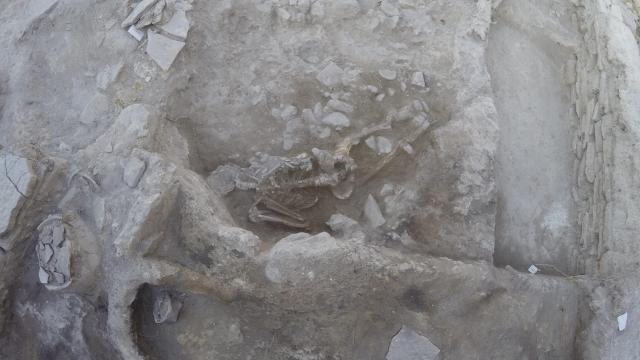A team of archaeologists and geoscientists just found victims of an ancient tsunami on the Turkish coast. The victims — a human male and a dog, now just skeletons — were likely killed in the aftermath of a gargantuan volcanic eruption 3,600 years ago.
The eruption was that of the Thera volcano on the island of Santorini, which happened around 1620 BCE. The eruption was so violent that much of Santorini was obliterated; the sliver of the island that remains is now a popular tourist destination. The eruption wreaked havoc on the Mediterranean, as a tremendous tsunami rolled outwards from the island and much of the region was blanketed in ash.
It’s no wonder that an event cited as the possible origin of the Atlantis myth or the Egyptian plagues discussed in the Bible had victims, like the recently discovered individuals in Turkey. The team’s recent discovery was reported this week in the Proceedings of the National Academy of Sciences.
The two skeletons were found at Çeşme-Bağlararası, a settlement on the Turkish coast that was occupied from the mid-third millennium BCE through the 13th century BCE, according to the paper. Archaeologists have previously found Late Bronze Age artifacts at the site. But recently, ash and tephra — material ejected in volcanic eruptions — have been turned up at the site. The researchers were able to trace the volcanic material in Turkey back to the Santorini eruption.
“The impact of this eruption, and the tsunamis it created were much stronger, and reached more regions than suggested before,” study co-authors Beverly Goodman, a marine geoarchaeologist at the University of Haifa in Israel, and Vasıf Şahoğlu, a maritime archaeologist at the University of Ankara in Turkey, wrote in a joint email. “Çeşme-Bağlararası is the northernmost site with tsunami deposits so far investigated, and is unique in that it is a site with very clear cultural and commercial maritime contacts with the Minoan World.”
But besides the volcanic material at the site, the team also found evidence that the ocean had paid a visit inland. Besides the human and canine remains at the site, the researchers found shells and urchins. They found a structure with a wall that had collapsed inward; it appeared that a dark, silty sediment had washed into the wall, causing it to implode.
The materials appeared to enter the site from one direction, leading the team to conclude it wasn’t the result of an earthquake. The research team is unsure whether the human — a healthy young man, perhaps a teenager — died from drowning, blunt force trauma, or even suffocated underneath the debris from the tsunami. But they are actively investigating that question.

The skeletons will be dated by the team in the coming months; if they date to the same timeframe as the Thera eruption, the human and dog remains would be some of the very few victims of the cataclysmic event ever found. (One other skeleton was reportedly seen during archaeological work in Theresia, the western island of Santorini, in 1886.)
“This research — we think — will be an eye opener for scientists working in the Aegean especially. For decades the primary focus of research on the Theran eruption mainly focused on the dating issue or the impact and the nature of the eruption itself, the ash distribution, along with the tsunamis it generated.” Goodman and Şahoğlu said.
“However, only a handful of sites have been reported with tsunami deposits, and none of them with human victims. This lack of human victims has been an enigma that has left a real knowledge gap regarding the human experience associated with the event,” they added.
Perhaps the most useful elements of the new work, though, are nine new radiocarbon ages taken from different materials on the site. The Thera eruption’s date is still contested; some think the eruption was around 1530 BCE (give or take a decade) or around 1620 BCE. Last year, a team of dendrochronologists dated the eruption to 1560 BCE, based on the tree rings of timber used in an ancient Phrygian tomb. The dates from Çeşme-Bağlararası indicate that the deposits can’t be older than 1612 BCE, though, potentially further constraining the Thera eruption dates.
But the skeletons’ ages will be helpful besides determining whether they were actually victims of the Thera event. Marine materials can be hard to date accurately with radiocarbon dating, so some researchers use different methods to date tsunamis. One team used optically stimulated luminescence technology last year to figure out when a paleotsunami hit the Levantine coast.
More interesting data is sure to come out of Çeşme-Bağlararası and the individuals — both human and canine — that died there. And perhaps more northern sites showing the extent of Thera’s damage will come in time, too.
